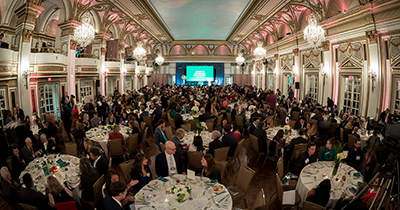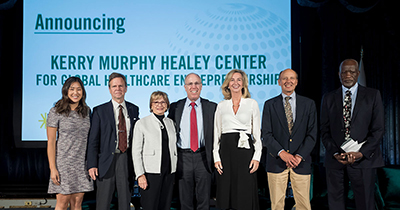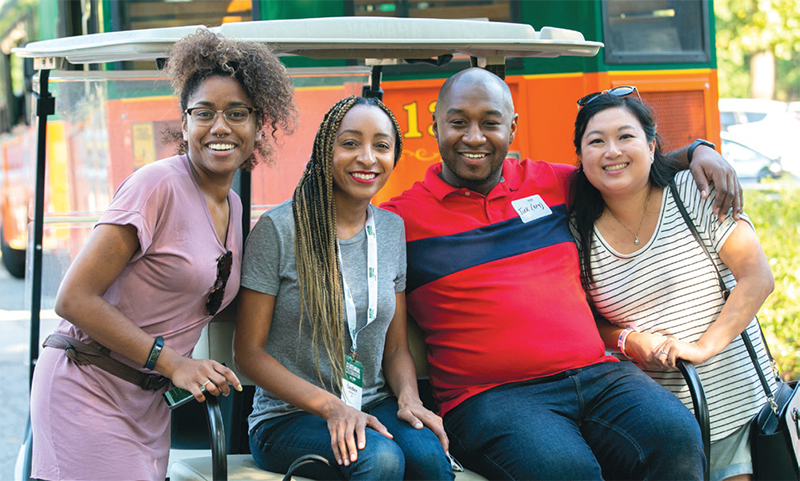
Alumni, faculty, staff, and friends gathered on campus for Back to Babson 2019, part of the Centennial Celebration in September. The record-breaking event, with more than 2,500 attendees, featured a Food & Wine Expo, a display of alumni-founded businesses, the Centennial Clambake at The Tent, and Reunion Class Parties.

Babson’s first women graduates celebrated their pioneering role in Babson’s history at a luncheon in September. The event, part of the weeklong Centennial Celebration, featured presentations from alumni, students, and the first female chair of the Board of Trustees, Marla Capozzi MBA’96.
See more stories and videos from Babson’s Centennial Celebration »
]]>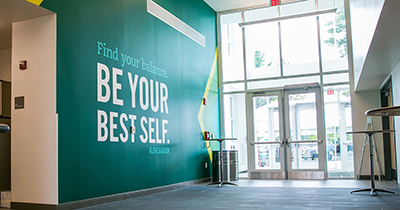
Babson Recreation and Athletics Complex Now Open »
From its Olympic lifting platforms outfitted with the Babson athletics logo to its array of cardio equipment and multipurpose courts, the newly completed Babson Recreation and Athletics Complex (BRAC) will help prompt community building, serving as a destination for students to pursue health and wellness initiatives, and as a programming space for a myriad of events.
TORq Interface Wins Big »
After three impressive pitches at Babson’s biggest business competition yet, Joanna Geisinger MBA’17 and her team at TORq Interface went home with $100,000 and the winning title.
Babson Inducts Three New Members into Academy of Distinguished Entrepreneurs »
This month, three esteemed entrepreneurs joined the Academy: Eric G. Johnson ’72, P’08, Baldwin Richardson Foods president and CEO, and Steve Conine and Niraj Shah, co-founders of Wayfair.
Babson to Establish a New Center Focused on Global Healthcare Entrepreneurship »
Babson is establishing the new Kerry Murphy Healey Center for Global Healthcare Entrepreneurship, thanks to $10 million in lifetime giving from Babson Board of Trustees member Carmella Kletjian.
]]>Richard Snyder graduated from Babson in 1960 and then went on to law school. He served as a White House summer intern and was a trial lawyer with the Department of Justice before entering private practice in 1966. Snyder continues to serve as legal counsel and advisor to business entities of all sizes, including for-profit and not-for-profit institutions and domestic and foreign corporations. He is a former chair of the Board of Trustees at Babson College and currently serves on the Global Advisory Board.
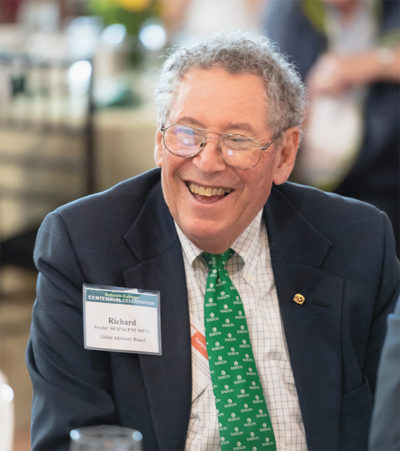
Richard J. Snyder ’60, H’94, P’93 ’01, trustee emeritus, Global Advisory Board
Photo: Justin Knight
What is your favorite memory of being a student at Babson?
Where the Globe is now used to be faculty housing, resulting in ’round-the-clock access to faculty. One could hang around and have access to them much of the time, just sit on the porch and talk about stuff. We solved problems and learned together.
Was there a Babson professor who really changed your life or made you look at life differently?
Walter Carpenter, who taught labor relations and later became dean of faculty—really a wonderful guy. He drove home the idea that if you want to have a successful business, management has a responsibility to have a supportive relationship with employees and treat them with respect. This changed my perspective.
Do you have any funny memories from a specific class or professor?
I majored in accounting because it was the only thing my dad would pay for. He believed that accounting was the only thing you couldn’t teach yourself. However, I really didn’t like accounting, so I often did not do the homework. My accounting professor, Clint Peterson, loved to call on me in class just to prove that I hadn’t done my homework. Luckily, I was able to bluff my way through it most of the time (or grab a friend’s homework and read the answers off!).
Who inspired you most at Babson?
Both Walter Carpenter and a liberal arts professor, John Gibson. Gibson was able to draw a connection between liberal arts and the business world, teaching us history, life, and a broader world view, which all contributed toward being an effective business person.
You have been giving back to Babson for more than 40 years. Why?
At the end of my second year at Babson, I interned at an accounting firm and really did hate it, so I decided to take the national law boards to apply to law school after Babson. I had no money but I scored so high on the law boards that I was granted a full scholarship to law school. Seeing how well I scored on a national test gave me insight into just how good my Babson education was. In fact, law school was less challenging than Babson!
I finished second in my class, made up of graduates of Harvard, Williams, and many of the best undergraduate programs. I never felt that anyone had a better education than I received at Babson. Being able to see firsthand how Babson stacked up against the best colleges around the country made me want to give back to Babson.
Not having a lot of money back then, I volunteered for the Alumni Association. Once I was able to donate more than just my time, I couldn’t conceive of putting money where it would do a greater good than Babson. In my opinion, a dollar invested in Babson had the highest possible return for succeeding generations.
What is your hidden talent?
The use of humor in business. I’m able to use humor as a negotiating technique because there is no defense against a joke, particularly if it’s self-effacing.
What job would you be terrible at?
CEO. I am very effective in a staff capacity where I can advise and present alternative ideas. However, I doubt I would be as effective if I had to choose one.
What does the future hold for Babson?
The need for Babson’s unique form of education across all aspects of societal development has never been greater, and Babson’s prospects have never been so bright. – Jillian Erdos
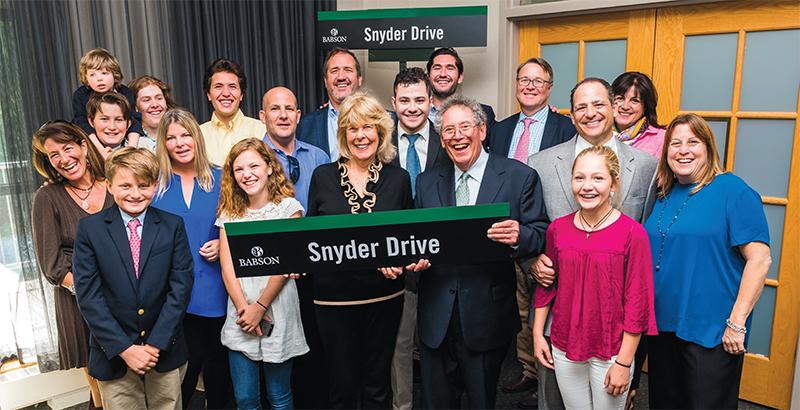
Richard Snyder ’60, H’94, P’93 ’01 and his wife, Marilyn B. Snyder MBA’80, P’93, with their family at the Snyder Drive Dedication on October 19, 2017.
Photo: Justin Knight

Richard J. Snyder ’60, H’94, P’93 ’01 »
Richard Snyder graduated from Babson in 1960 and then went on to law school. …

Eric Dosal ’00 »
Eric Dosal is a Class of 2000 alumnus who currently lives in Miami with his wife, Lorena, and their two daughters. …

Pam Buckley ’89 »
Pam Buckley graduated from Babson in 1989, following in the footsteps of her father, Raymond J. Acciardo Sr. MBA’69. …
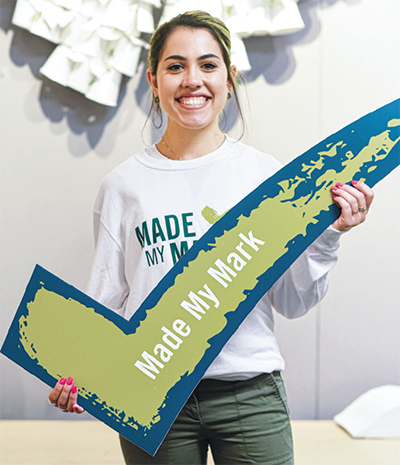
A record-setting Make Your Mark
This year’s Make Your Mark was a record-breaking day of giving and a grand display of the Babson community’s philanthropic spirit. With over $330,000 raised, this event marked the most gifts given on a single day in Babson history. Babson’s annual day of giving attracted 2,178 donors from 37 countries and 43 states—342 of which were first-time donors.
On behalf of the entire community, thank you for helping to make Babson remarkable.
]]>
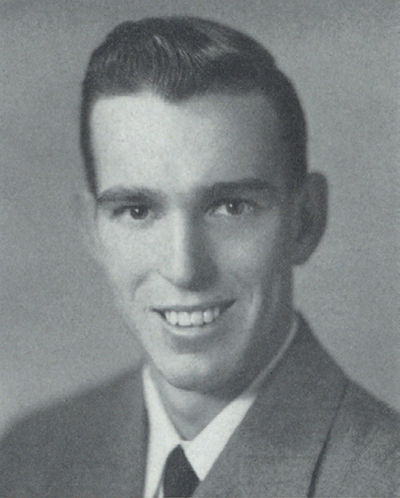
Jack Dewey, 1949
Fortunately for Dewey, that great conflict, World War II, ended a few months later. He would spend the next year or so aboard a cargo ship tasked with doing repair work of other vessels. Sailing around a world newly at peace, Dewey and his fellow sailors were welcomed everywhere they went. “Everybody loved us,” Dewey remembers.
When his time in the Navy was over, Dewey came to Babson. In the fall of 1946, he joined other returning veterans eager to settle into civilian life. That group of students, the Class of ’49, swelled enrollment at the school and brought a new vitality to the institution.
In the decades that followed, they also established a robust scholarship fund that continues to make an impact on Babson students today. “We think the scholarship program has succeeded beyond our wildest dreams,” says Dewey.
As was typical of the Greatest Generation, Dewey and his fellow students didn’t dwell on their war experiences while at Babson. Sure, they might relay a funny story from their time in the service, but otherwise, they were ready to focus on their studies and start their careers. “I can never remember anyone talking about war or battles,” Dewey says. “It was past.” Dewey was one of 253 men to earn their degrees in 1949, and he went on to work at Liberty Mutual Insurance for 40 years. He also remained involved with Babson for decades, as Bill Cruickshank ’49, H’99, one of Babson’s biggest cheerleaders, would recruit Dewey to help with raising funds from their fellow classmates.
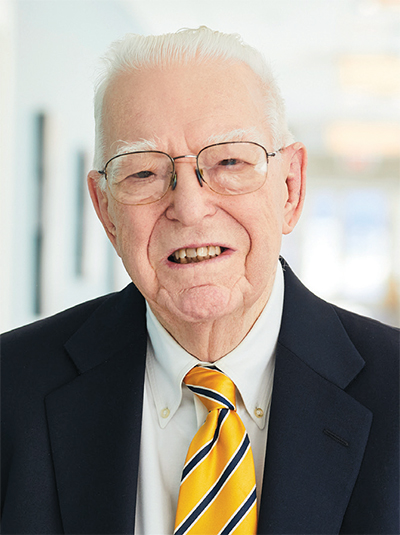
Jack Dewey, 2019
Photo: Pat Piasecki
“You could not say no to Bill,” says Dewey, who in September received the Richard J. Snyder Distinguished Service to the College Award.
In 1984, the Class of ’49 established its scholarship fund in honor of its 35th reunion. Through the years, the scholarship has been awarded to nearly 250 students. “You ought to see the achievements of our scholars,” Dewey says. “I am very proud of that.”
Today, only 24 members of the Class of ’49 remain, as the relentless march of time has taken its toll. Dewey lives at the North Hill retirement community, located just down the road from Babson. Considering that North Hill sits on land actually owned by Babson, people who know Dewey like to joke: “Jack loved the College so much that he never left the campus.” – John Crawford
Editor’s Note: With great admiration and heartfelt sadness, we dedicate this story to Jack Dewey, who passed away in October.
]]>In 2014, the Bertarelli Foundation gave a $3 million gift to the College to endow a faculty chair, the Bertarelli Foundation Distinguished Professor of Family Entrepreneurship, and recently contributed to the building of the new Kerry Murphy Healey Park. Former President Healey recently presented the award to Bertarelli, who was inducted into Babson’s Academy of Distinguished Entrepreneurs® in 2008.
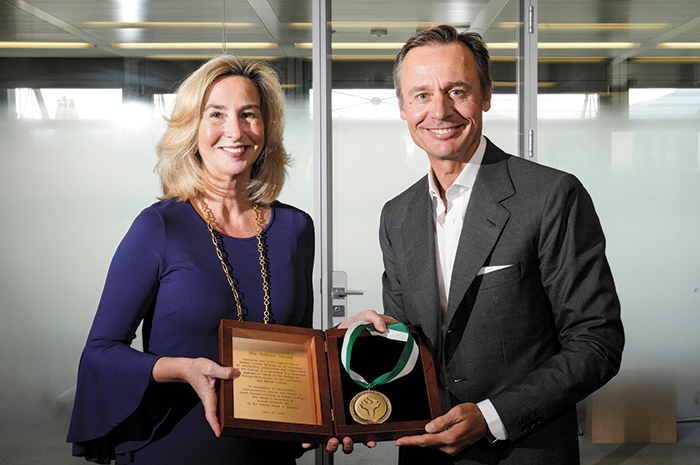
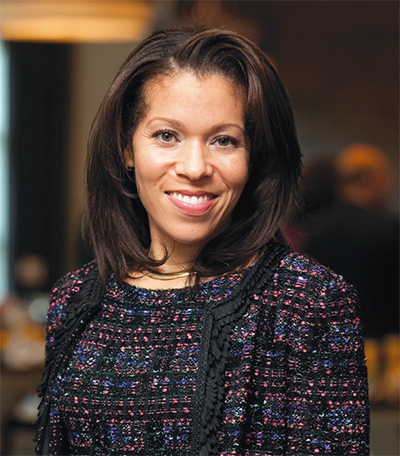
A full scholarship to Babson was a gift Mikki Wosencroft ’99 has never forgotten.
“It’s been on my mind ever since I got the scholarship that one day I’ll pay this back,” she says, “because I knew that I wouldn’t be here without it.”
By “here,” Wosencroft means director of human resources, North America, at the fashion and luxury goods company Celine in New York City. Prior to that, she held positions at Morgan Stanley, Merrill Lynch, and L’Oréal. “Almost all of the jobs I’ve had,” she adds, “were the result of some point of reference of my Babson education.”
Wosencroft became part of the Babson Legacy Society with a charitable bequest through her life insurance, so she could make similar scholarships available to students in need. The Legacy Society offers an array of planned gift options for alumni and friends of the College, which can support campus programs and initiatives that are most personally meaningful. “Everything I have is from the education I got,” she says. Comparing notes with friends from high school after her first year at Babson, she remembers realizing she already was ahead of the game: “While they were taking general ed classes, I already knew how to break down a balance sheet and understood why they changed the queueing at Starbucks.”
Richard Abbott
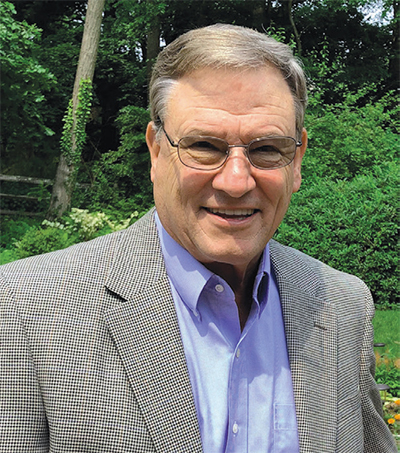
Richard Abbott ’69 re-established his ties with Babson about five years ago, and joining the Babson Legacy Society has been part of that connection. He is hopeful his former classmates can return to campus, especially during their milestone 50th reunion year and in honor of the College’s Centennial.
“The major capital investments at the College are impressive,” says the retired management executive. “The national and international outreach programs continue to make Babson academically recognized, and I strongly support the continued growth of athletics and campus organizations that encourage alumni to remain connected to the College.”
For more information about how you can become a member of the Babson Legacy Society, please visit babson.giftplans.org, or contact Sandra Anthoine at santhoine@babson.edu or 781-239-4352.
]]>The goalie looked toward his jubilant teammates huddling together on the field. He spotted Jon Anderson ’75, P’04 ’08 ’13 ’13, a midfielder known as “Jonny A” to the team. “I remember Jonny A. coming off the pile and running toward me, arms wide open,” says Kennedy. “It was quite a moment.”
As part of Babson’s Centennial celebrations, all five of the school’s national champion squads—the 1975, 1979, and 1980 men’s soccer teams, the 1984 men’s ice hockey team, and the 2017 men’s basketball team—will be inducted into the Athletics Hall of Fame in September.
The 1975 championship, Babson’s first, brought lots of publicity to an institution that was coming into its own, both athletically and academically. “Nobody knew anything about this school,” Anderson says. “We were buried in the woods of Wellesley.”
That was evident in the semifinal of the national tournament, when Babson played a confidant Ohio Wesleyan University. But Babson stunned the team, defeating them 5-0, and then went on to shut out the defending champion, The College at Brockport, 1-0, for the title.
The Beavers arrived back to campus late and were surprised to see their fellow students lining College Drive to welcome them home. “It was an incredible scene,” says Anderson.
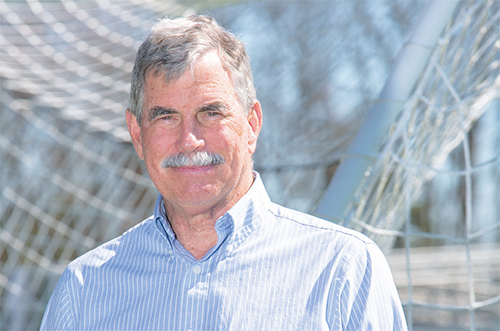
Coach Jon Anderson
Photo: Paige Brown
Outscoring opponents by a combined score of 61-5, the 1975 team finished the season unbeaten. Much credit goes to head coach Bob Hartwell for building a strong program at a school not known for athletic excellence. “He wanted a program filled with pride and tradition,” says Anderson.
These days, Anderson is Babson’s head men’s soccer coach, having led the Beavers for 33 seasons. Kennedy, a sculptor in California who created the Babson Totem by the athletics fields, also coaches high school soccer. He remembers how Hartwell pushed the team to do its best. “There was an expectation that you were going to fight and give it all you had,” he says. “We fed off that.” – John Crawford
]]>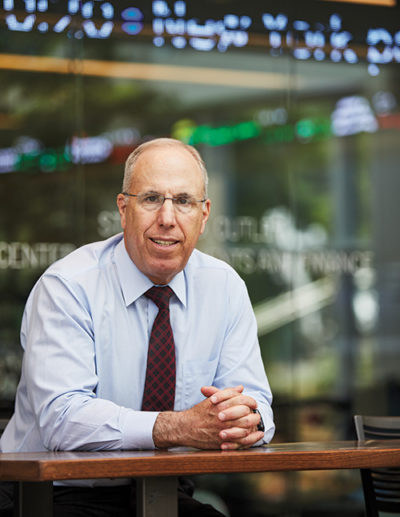
Stephen Spinelli Jr. MBA’92, PhD
Photo: Pat Piasecki
Being back at Babson is an exciting homecoming. I have held many Babson titles over the past three decades: student, faculty, alumus, and leader. Now, my career as an entrepreneur and academic comes full circle, and I am honored and energized to add president to that list.
Over the past seven months, I have met thousands of members of the Babson community at hundreds of events and meetings on campus and around the world. Hearing from this smart and passionate community has been inspiring. My goal is to continue to engage with all of you in ways that are meaningful to you, valuable to the College, and impactful for our students.
As I return to Babson, it is clear that while much has changed—including our newly transformed campus—Babson remains dedicated to teaching and learning, and committed to excellence. The trajectory of growth at Babson has been immense, and the culture of entrepreneurship and consistency of mission is motivating and important. Today, the world needs entrepreneurship more than ever.
The pace of change in the world and workplace is accelerating, and every industry, including higher education, is being disrupted. Disruption and change create new opportunities to advance our differentiator—Entrepreneurial Thought & Action®. By engaging the entire Babson community in a collaborative strategic planning process, we will prepare the College to thrive in today’s evolving environment. I ask you to participate in this effort and to share your input and ideas as we plan for Babson’s future (see The Courage to be Bold for more information on strategic planning).
I look forward to connecting with you as we continue to celebrate Babson’s Centennial and envision our next 100 years. The enthusiasm and collaboration of the global Babson community will empower our ongoing innovation and success and build on our legacy and leadership in entrepreneurship education. It is great to be back at Babson.
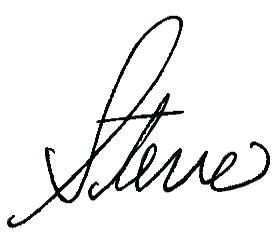
Stephen Spinelli Jr. MBA’92, PhD
Since then, Kerry Healey was named the first female president in 2013, and Marla Capozzi MBA’96 first female chair of the Board of Trustees in 2017. The Centennial undergraduate class of 2019 was the first to have a female majority. In September, women from the first decade of graduating classes will return to the College as the Pioneering Women of Babson, partnering with the Center for Women’s Entrepreneurial Leadership to support current and future students and alumnae and inspire engagement and donations.
We asked some of these women to share their memories of campus and to offer advice to women students today.

Carolyn Levosky MBA’69
Photo: Webb Chappell
Carolyn Levosky MBA’69
The first woman to earn a master’s degree
“These were changing times, but I still thought it was very brave of Babson to accept women. It was a bit experimental on their end, but I’m sure they saw the trends. The MBA students were a little older, and very welcoming, very open-minded.
“I was not trying to prove anything. When I graduated, they put my picture on the front page of The Boston Globe. It was a very big event. But I was just trying to do a good job for the next group of women, and I was glad to be early in the game. I think the writing was on the wall that women were going to go to graduate school and into the workforce in a big way.”
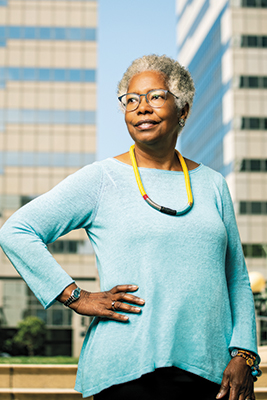
Sharon Rowser ’74
Photo: Winni Wintermeyer
Sharon Rowser ’74
“I was offered a full scholarship, and Babson showed a lot more interest in me than other schools I applied to. The civil rights movement was happening during that time, and colleges were reaching out to bring more minority students in, so I knew I was part of that. There was definitely a sense in those days that you were representing your people. A lot of single-sex schools were becoming coed then. What was more startling was how small the African-American population was. I was the only African-American woman in the school my first year. It’s complicated, and a bit emotional, too; it made me feel pretty alone, even though in high school it wasn’t unusual for me to be in classes with few African-Americans. Freshman year was the hardest, and it was definitely the living and social parts that made it hard. I felt I was as smart as everyone else, and I wasn’t afraid to show that. I was part of the Black Students Union, and we worked as a group to recruit more students of color in my first two years at Babson.”
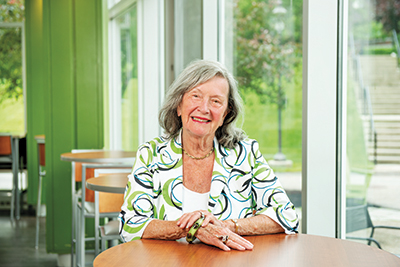
Sandra Adams ’70
Photo: Webb Chappell
Sandra Adams ’70
One of the first two women to earn undergraduate degrees
“I wanted to be an investor, so I transferred from Wellesley College in 1968. Babson had a good program. I was pleased to go there. I was a bit older and already had children. The guys were wonderful. They were as nice as they could be, even if they never saw anything like us before on campus. I had a great time. I wish I could be that age again and do it all over. Babson has a lot of women now. Isn’t that fantastic? I think they would be very happy to step into what Babson offers. It’s all there for them.”
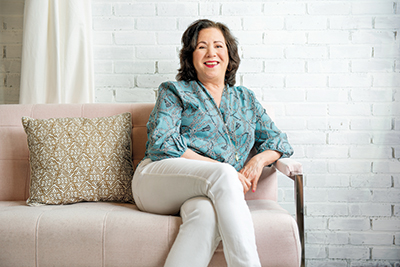
Phyllis Speen ’74
Photo: Webb Chappell
Phyllis Speen ’74
“When I came to Babson I didn’t really think about being one of few women. I wasn’t intimated by that. As women we just did what we wanted to do. A percentage of the guys at Babson came from all-male prep schools, and they weren’t sure how to treat women academically or even socially. They looked at you as a nuisance, usually not as dating material. And then there was a percentage that just were like brothers and would help you. The one thing you’ll hear from many women or men who were the first of something, was that we had the burden of having to succeed no matter what, because we were representative. For three-quarters of my career, I was usually the first or only woman in my role. I never knew not needing to succeed, because I was afraid it would be looked at as women couldn’t do it, versus Phyllis couldn’t do it.”
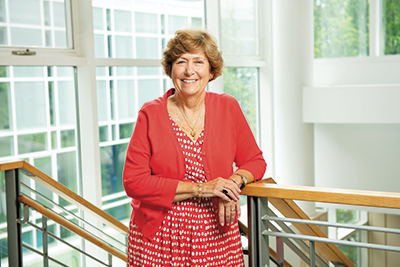
Anne McCormick Heller ’70
Photo: Webb Chappell
Anne McCormick Heller ’70
One of the first two women to earn undergraduate degrees
“There were only two of us in the undergraduate school. And there were no women faculty. There were no women in senior positions. There were no women’s sports. No clubs. I was working hard. It was competitive, but the male students treated me great. They were collegial and easy. I became part of campus life and was on student government. I had great professors. They made me totally comfortable in the classroom.”
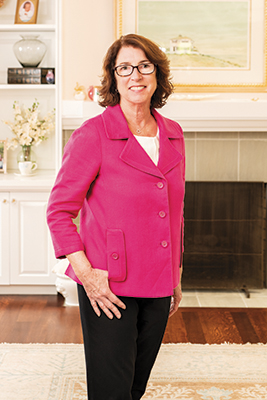
Ellen Monahan Saliba ’74, MBA’80
Photo: Winni Wintermeyer
Ellen Monahan Saliba ’74, MBA’80
“I entered Babson in September 1970. That was the pivotal point. Prior to that, there were a few women. But that September, they admitted about 25. It was not pervasive, but there was an attitude of, what are these women doing here? That kind of stuff went away pretty quickly as they got to know us. We were there to get an education. I don’t think any of the women chose Babson to make a statement.
“We stuck together. To walk into Trim Dining Hall, it was uncomfortable at times. We felt we were very visible, so we would gather at 5:30 in the dorm and walk over together. The women were such a good support structure. We were allowed to put our mark on the school by being leaders on the newspaper, yearbook, student government. I got a great education. I was so well-prepared for life and for working in a world that is male dominated.”
The Pioneers’ Words of Wisdom
Ellen Monahan Saliba:
“Life is long. Keep going. Don’t let a roadblock slow you down from what you want to do.”
Anne McCormick Heller:
“It’s a global world. Take advantage of the international population at the undergrad and grad school. Meet these folks.”
Carolyn Levosky:
“If you’re competent and really know what you’re doing, when you’re speaking to someone, they’re going to listen to you. It doesn’t matter if you’re a man or a woman. If you have credibility, that makes a huge difference.”
Sharon Rowser:
“We’ve made strides, both racially and genderwise, but we still have to pay attention, because discrimination has not gone away.”
Phyllis Speen:
“If you’re in sales, know your audience and talk in terms of their world. Selling is a skill. It’s about listening, asking questions, and understanding someone’s perspective. We should really change the word ‘sales’ to ‘communication’.”

